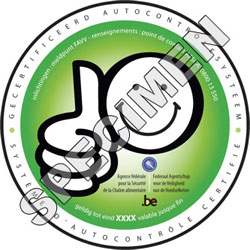Nikki Marcotte, a new student, tries out her translation skills on a piece from French food safety blogger, Albert Amgar.
I n Conseil National de l’Alimentation’s newsletter No. 13, dated June 11, 2010, we learn about health safety: an increased effort between the three unions of the Groupement National de la Restauration.
n Conseil National de l’Alimentation’s newsletter No. 13, dated June 11, 2010, we learn about health safety: an increased effort between the three unions of the Groupement National de la Restauration.
“Given the issues with health safety and nutrition in the catering business, these three entities (the National Institutional Restaurant Services Union, the National Fast-Food and Food Union, the National Union of Themed and Commercial Restaurants, all three members of the GNR) have decided to combine forces and work together on these common problems. Three work groups have been created, each with two representatives from each syndicate, all experts in issues of ‘hygiene’, ‘nutrition’ and ‘quality’.”
One of the work groups has devoted their time to food safety. What is their objective?
The goal of the work group, in regard to regulatory requirements and their recent developments, is to pool together technical skills and the scientific expertise required to validate certain methods of disease control common to various restaurant activities: time-temperature combinations/storage temperatures of foods in certain conditions, microbiological monitoring methods…
According to the Ministry of Agriculture, “Industrial and restaurant catering is comprised of commercial food services (approximately 15% of meals served) and collective food services (85% of meals served). The latter represents close to 4 billion meals.”
Collective food service professionals contribute to three different areas: education (school catering, 1 billion meals, and university catering), health and social services (hospital, nursing home and prison catering), and the workforce (business and administrative catering). Likewise, process hygiene criteria have been implemented.
The ministry also tells us that there are more than “…30,000 inspections conducted annually in the three large collective food service sectors, including nearly 13,000 in the school catering area. In particular, these checks are aimed at ensuring:
– good food preparation practices (in terms of the hygiene and handling of the equipment), transport and storage (with respect to the hygiene and handling of the equipment);
– the cold chain;
– the recommendations concerning the use of pasteurized eggs to prevent foodborne illnesses associated with salmonella.”
“More than 30,000 inspections…” of which we know nothing about, not even one annual statistic… (transparency, where are you?).
This blog, which is always ready to help food service professionals with these excellent initiatives, wishes to make a contribution with this recent publication .png) from the barfblog team, see, “Food safety information posted in restaurant kitchens can improve meal safety.” Source: Chapman, Benjamin; Eversley, Tiffany; Fillion, Katie; MacLaurin, Tanya; Powell, Douglas. Assessment of Food Safety Practices of Food Service Food Handlers (Risk Assessment Data): Testing a Communication Intervention (Evaluation of Tools). Journal of Food Protection®, Volume 73, Number 6, June 2010, pp. 1101-1107(7).
from the barfblog team, see, “Food safety information posted in restaurant kitchens can improve meal safety.” Source: Chapman, Benjamin; Eversley, Tiffany; Fillion, Katie; MacLaurin, Tanya; Powell, Douglas. Assessment of Food Safety Practices of Food Service Food Handlers (Risk Assessment Data): Testing a Communication Intervention (Evaluation of Tools). Journal of Food Protection®, Volume 73, Number 6, June 2010, pp. 1101-1107(7).
This blog could also suggest to the Ministry of Food less opacity in these inspections so that the consumer is fully informed, and to maybe also think about the scoring system or grades on the doors of restaurants or to start slowly putting the inspection results online. Also look at the “smiley” example in Belgium (above right).

.jpg) announce their cleanliness.
announce their cleanliness. use smiley faces).
use smiley faces)..jpg) Mr al Reyaysa further noted the restaurants closed were “fraught with potential danger to the health of the consumers”, such as kitchens infested with insects, improper drainage systems and waste disposal, and mixing meat and fruits.
Mr al Reyaysa further noted the restaurants closed were “fraught with potential danger to the health of the consumers”, such as kitchens infested with insects, improper drainage systems and waste disposal, and mixing meat and fruits..jpg) Robert Bookman, legislative counsel for the New York City chapters of the New York State Restaurant Association — the operators’ trade group — told
Robert Bookman, legislative counsel for the New York City chapters of the New York State Restaurant Association — the operators’ trade group — told .png) test results on the website — to help enhance trust with the buying public. And the best restaurants will proudly proclaim their A.
test results on the website — to help enhance trust with the buying public. And the best restaurants will proudly proclaim their A.